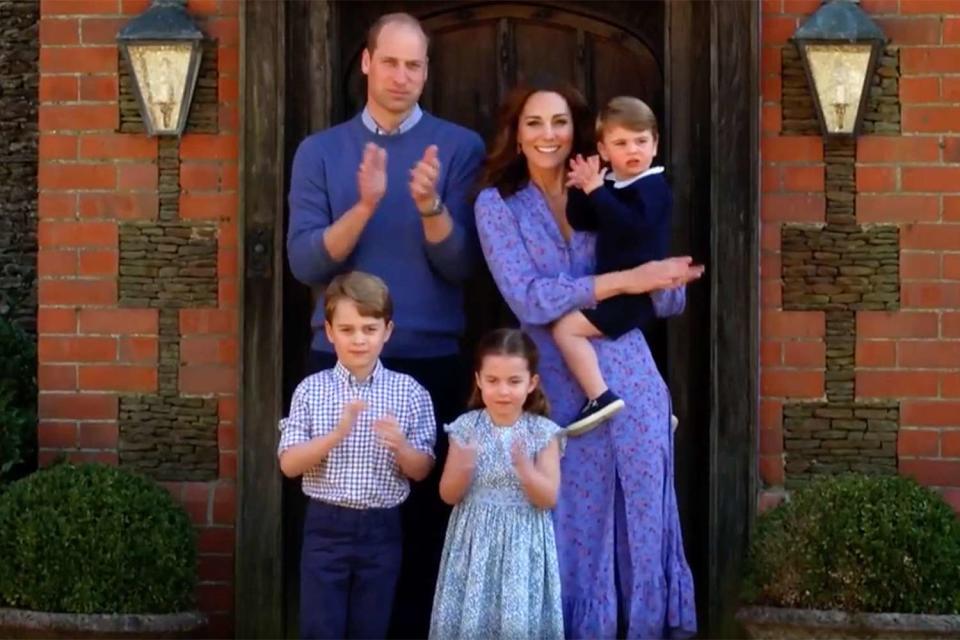Why Kate Middleton's Photography Skills Are Her 'Soft Power'
Kate Middleton’s family photographs have warmed the hearts of millions during the coronavirus pandemic.
Yet the images of Prince George, 6, Princess Charlotte, 5, and little brother, Prince Louis, 2, spending quality family time together during isolation at Kate and Prince William’s Anmer Hall country home in Norfolk are far more than simple family snaps.
Instead, they form an integral part of what royal historian Lucy Worsley calls the royal family’s “very own superpower.”
RELATED: Princess Charlotte Is on a Special Mission in Her New Birthday Portraits: See All 4!

BBC Prince William, Kate Middleton, Prince Louis, Prince George and Princess Charlotte
“For 200 years the British monarchy has used photography,” she adds in a new BBC documentary Lucy Worsley's Royal Photo Album, which airs on PBS on August 16. “From creating a new sovereign to affairs of the heart, majestic moments to everyday life, when monarchy wants to send a message it uses a photograph.”

The Duchess of Cambridge Princess Charlotte
Worsley highlights this by profiling the way that key royals, including Prince Harry, Princess Diana, Princess Margaret and Queen Elizabeth, have used photographs to send a message to the world.
A post shared by Duke and Duchess of Cambridge (@kensingtonroyal) on Mar 26, 2020 at 1:00pm PDT
It is all part of the royal family’s “soft power," she says.
"You would think that the weapons of a king and queen were perhaps their armies or centuries of tradition but what they have is the power of the media,” Worsley tells PEOPLE. "The visual is almost more important than words because they don't have that many opportunities to speak.
“So, they have become very adept at using photo opportunities: dressing, body language, who they are photographed with — all that sort of thing — to express their influence. Because they don't have power, but they do have influence.”
A post shared by Duke and Duchess of Cambridge (@kensingtonroyal) on Mar 22, 2020 at 2:00am PDT
Can't get enough of PEOPLE's Royals coverage? Sign up for our free Royals newsletter to get the latest updates on Kate Middleton, Meghan Markle and more!
This reliance on photographs stretches all the way back to Prince Albert, the first British royal to have his photo taken in 1842.
Together with Queen Victoria, the Albert developed a more relaxed style of photography that showed the royal family relaxing together just like any other middle-class family. This has since been built on by successive generations including Queen Alexandra, George VI, and more recently, Kate.
“It makes them relatable and therefore builds affection,” says Worsley. "They work in exactly the same way as a soap opera does. These are people whose lives sort of mirror your own. They progress. They have births, deaths and marriages. You get to know them over time. You feel like they are your friends — sort of!”
She adds, "People talk about it (the royal family) as a high brand institution, but it so isn't. It's really, really adapted. They use Instagram and what have you, but they reference the past. They make decisions that appear consistent with the past.”
It is for this reason that Worsley says, "The Duke and Duchess of Cambridge now dominate my Instagram feed!”
Here are some key moments in royal photography, as described by Worsley in Royal Photo Album:
Charles and Diana's Balcony Kiss

Reginald Davis/Rex Features
“It was photography that froze that moment and created one of the most celebrated images of the 20th century," Worsley says in the BBC's Royal Photo Album.
Queen Elizabeth's Coronation Image

Cecil Beaton. Royal Collection Trust/ Her Majesty Queen Elizabeth II 2015
“An image enthused with glamor and more than a hint of camp," says Worsley. "Elizabeth was transformed into a sovereign with star quality."
Sultry Princess Margaret

Popper Ltd./ullstein bild/Getty
“While the rest of the royals were busy being a bit ‘Victorian,’ Margaret was refreshingly modern," says Worsley. "Margaret was quite happy to be photographed showing a bit of shoulder, wearing sunglasses, even smoking.
"But these images reveal Margaret’s dilemma. She didn’t want to be the black sheep of the royal family. She wanted to be part of the whole thing. And yet, as she put it, ‘disobedience is my joy’."
Prince Harry

Chris Jackson/Getty
“Margaret’s role as the more glamorous sideshow to the main event has been passed down through generations," says Worsley. “Harry and Meghan’s decision to step back from royal duties may give them even more say over how their images are used."
Edward VIII and Wallis Simpson

Fox Photos/Getty Images
Photographs of Wallis and Edward enjoying a private cruise on the Adriatic Sea hit the British front pages in December 1936.
"They were explosive,” says Worsley. “I don’t think it’s at all an accident that just a few days later he abdicated."
The former King then became something that no British royal had ever been before, says Worsley: "fair game" to the paparazzi.
Princess Diana

Tim Graham/Getty
“She conveyed a level of compassion and emotion rarely before captured in royal photographs," says Worsley. "She proved to have an amazing grasp of how photography works."
Queen Victoria

W. & D. Downey/Getty
“Victoria and Albert were early adopters of photography. They got into it when it was still a wonder of science and they would use it to change the relationship between the monarchy and its people," says Worsley. “The invention of the camera enabled the reinvention of the British monarchy for the modern era.”


